A Comparative Analysis of Global Supply Chain and Local Supply Chain
VerifiedAdded on 2022/05/11
|11
|3566
|431
Report
AI Summary
This report provides a comparative analysis of global and local supply chains, examining their implications, advantages, and challenges. The introduction highlights the growing importance of addressing social and environmental issues within supply chains, especially in light of the United Nations Sustainable Development Goals (SDGs). The report discusses the implications of both supply chain models, particularly in the context of the COVID-19 pandemic. It then delves into the advantages of local supply chains, such as increased flexibility, community support, easier travel, and environmental benefits. The report also outlines the challenges associated with local supply chains. Subsequently, it explores the advantages of global supply chains, including higher efficiency, the ability to stay on top of demand, minimized delays, and reduced overhead costs, while also acknowledging the challenges such as exchange rates and foreign transaction costs. The report concludes by summarizing the key differences and considerations for businesses when choosing between global and local supply chain models.

GLOBAL SUPPLY CHAIN vs LOCAL SUPPLY CHAIN
Paraphrase This Document
Need a fresh take? Get an instant paraphrase of this document with our AI Paraphraser
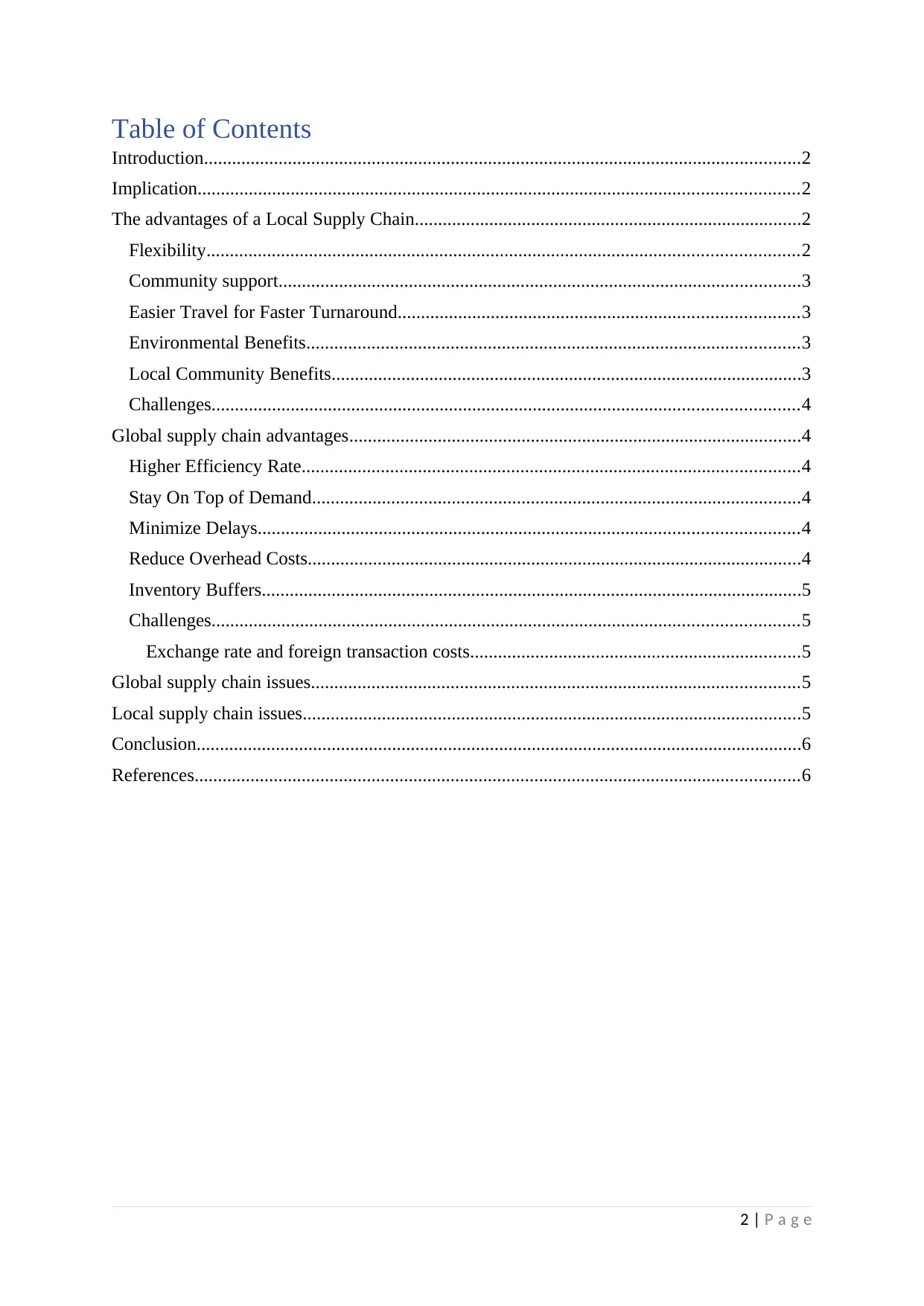
Table of Contents
Introduction................................................................................................................................2
Implication.................................................................................................................................2
The advantages of a Local Supply Chain...................................................................................2
Flexibility...............................................................................................................................2
Community support................................................................................................................3
Easier Travel for Faster Turnaround......................................................................................3
Environmental Benefits..........................................................................................................3
Local Community Benefits.....................................................................................................3
Challenges..............................................................................................................................4
Global supply chain advantages.................................................................................................4
Higher Efficiency Rate...........................................................................................................4
Stay On Top of Demand.........................................................................................................4
Minimize Delays....................................................................................................................4
Reduce Overhead Costs..........................................................................................................4
Inventory Buffers....................................................................................................................5
Challenges..............................................................................................................................5
Exchange rate and foreign transaction costs.......................................................................5
Global supply chain issues.........................................................................................................5
Local supply chain issues...........................................................................................................5
Conclusion..................................................................................................................................6
References..................................................................................................................................6
2 | P a g e
Introduction................................................................................................................................2
Implication.................................................................................................................................2
The advantages of a Local Supply Chain...................................................................................2
Flexibility...............................................................................................................................2
Community support................................................................................................................3
Easier Travel for Faster Turnaround......................................................................................3
Environmental Benefits..........................................................................................................3
Local Community Benefits.....................................................................................................3
Challenges..............................................................................................................................4
Global supply chain advantages.................................................................................................4
Higher Efficiency Rate...........................................................................................................4
Stay On Top of Demand.........................................................................................................4
Minimize Delays....................................................................................................................4
Reduce Overhead Costs..........................................................................................................4
Inventory Buffers....................................................................................................................5
Challenges..............................................................................................................................5
Exchange rate and foreign transaction costs.......................................................................5
Global supply chain issues.........................................................................................................5
Local supply chain issues...........................................................................................................5
Conclusion..................................................................................................................................6
References..................................................................................................................................6
2 | P a g e
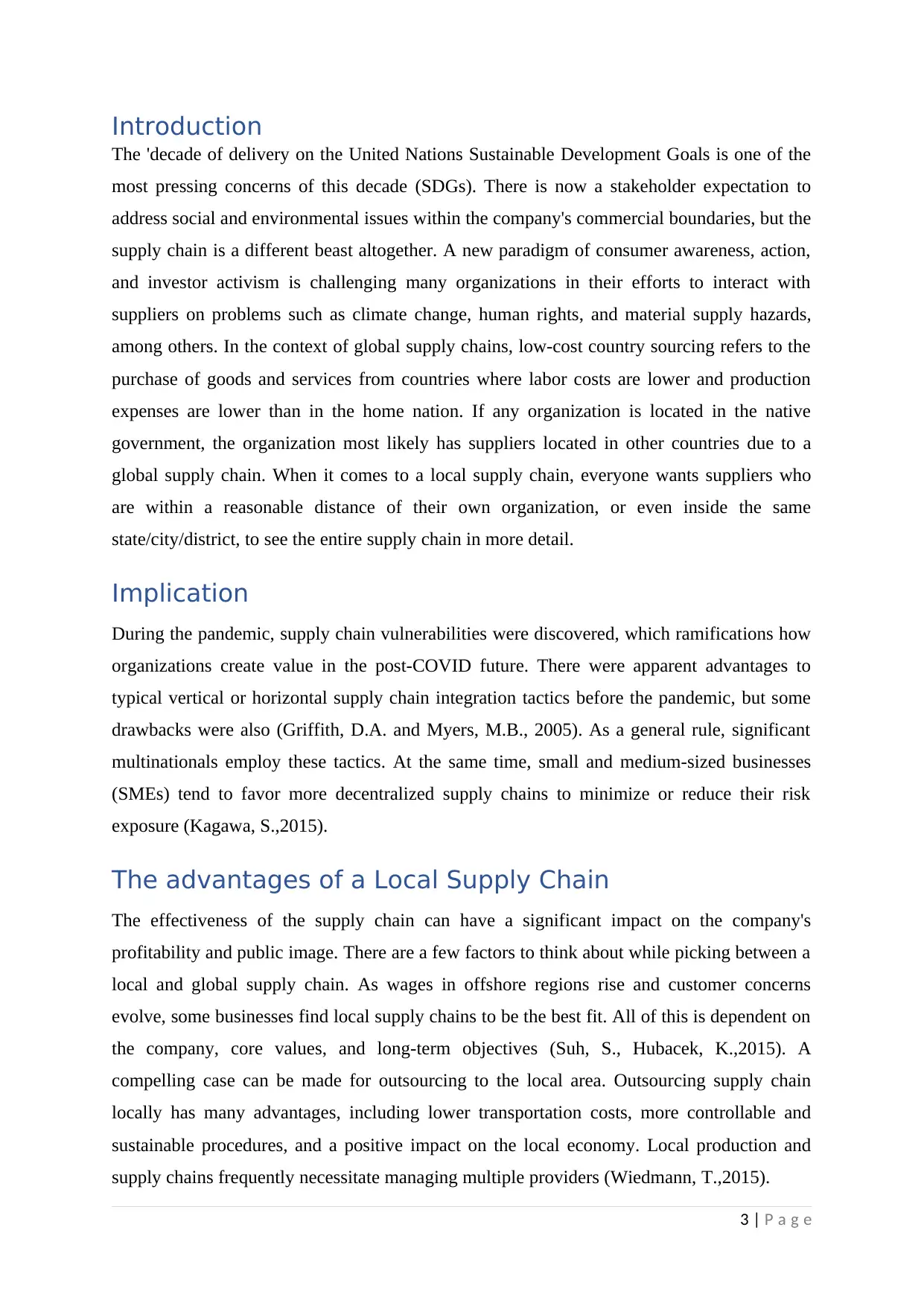
Introduction
The 'decade of delivery on the United Nations Sustainable Development Goals is one of the
most pressing concerns of this decade (SDGs). There is now a stakeholder expectation to
address social and environmental issues within the company's commercial boundaries, but the
supply chain is a different beast altogether. A new paradigm of consumer awareness, action,
and investor activism is challenging many organizations in their efforts to interact with
suppliers on problems such as climate change, human rights, and material supply hazards,
among others. In the context of global supply chains, low-cost country sourcing refers to the
purchase of goods and services from countries where labor costs are lower and production
expenses are lower than in the home nation. If any organization is located in the native
government, the organization most likely has suppliers located in other countries due to a
global supply chain. When it comes to a local supply chain, everyone wants suppliers who
are within a reasonable distance of their own organization, or even inside the same
state/city/district, to see the entire supply chain in more detail.
Implication
During the pandemic, supply chain vulnerabilities were discovered, which ramifications how
organizations create value in the post-COVID future. There were apparent advantages to
typical vertical or horizontal supply chain integration tactics before the pandemic, but some
drawbacks were also (Griffith, D.A. and Myers, M.B., 2005). As a general rule, significant
multinationals employ these tactics. At the same time, small and medium-sized businesses
(SMEs) tend to favor more decentralized supply chains to minimize or reduce their risk
exposure (Kagawa, S.,2015).
The advantages of a Local Supply Chain
The effectiveness of the supply chain can have a significant impact on the company's
profitability and public image. There are a few factors to think about while picking between a
local and global supply chain. As wages in offshore regions rise and customer concerns
evolve, some businesses find local supply chains to be the best fit. All of this is dependent on
the company, core values, and long-term objectives (Suh, S., Hubacek, K.,2015). A
compelling case can be made for outsourcing to the local area. Outsourcing supply chain
locally has many advantages, including lower transportation costs, more controllable and
sustainable procedures, and a positive impact on the local economy. Local production and
supply chains frequently necessitate managing multiple providers (Wiedmann, T.,2015).
3 | P a g e
The 'decade of delivery on the United Nations Sustainable Development Goals is one of the
most pressing concerns of this decade (SDGs). There is now a stakeholder expectation to
address social and environmental issues within the company's commercial boundaries, but the
supply chain is a different beast altogether. A new paradigm of consumer awareness, action,
and investor activism is challenging many organizations in their efforts to interact with
suppliers on problems such as climate change, human rights, and material supply hazards,
among others. In the context of global supply chains, low-cost country sourcing refers to the
purchase of goods and services from countries where labor costs are lower and production
expenses are lower than in the home nation. If any organization is located in the native
government, the organization most likely has suppliers located in other countries due to a
global supply chain. When it comes to a local supply chain, everyone wants suppliers who
are within a reasonable distance of their own organization, or even inside the same
state/city/district, to see the entire supply chain in more detail.
Implication
During the pandemic, supply chain vulnerabilities were discovered, which ramifications how
organizations create value in the post-COVID future. There were apparent advantages to
typical vertical or horizontal supply chain integration tactics before the pandemic, but some
drawbacks were also (Griffith, D.A. and Myers, M.B., 2005). As a general rule, significant
multinationals employ these tactics. At the same time, small and medium-sized businesses
(SMEs) tend to favor more decentralized supply chains to minimize or reduce their risk
exposure (Kagawa, S.,2015).
The advantages of a Local Supply Chain
The effectiveness of the supply chain can have a significant impact on the company's
profitability and public image. There are a few factors to think about while picking between a
local and global supply chain. As wages in offshore regions rise and customer concerns
evolve, some businesses find local supply chains to be the best fit. All of this is dependent on
the company, core values, and long-term objectives (Suh, S., Hubacek, K.,2015). A
compelling case can be made for outsourcing to the local area. Outsourcing supply chain
locally has many advantages, including lower transportation costs, more controllable and
sustainable procedures, and a positive impact on the local economy. Local production and
supply chains frequently necessitate managing multiple providers (Wiedmann, T.,2015).
3 | P a g e
You're viewing a preview
Unlock full access by subscribing today!
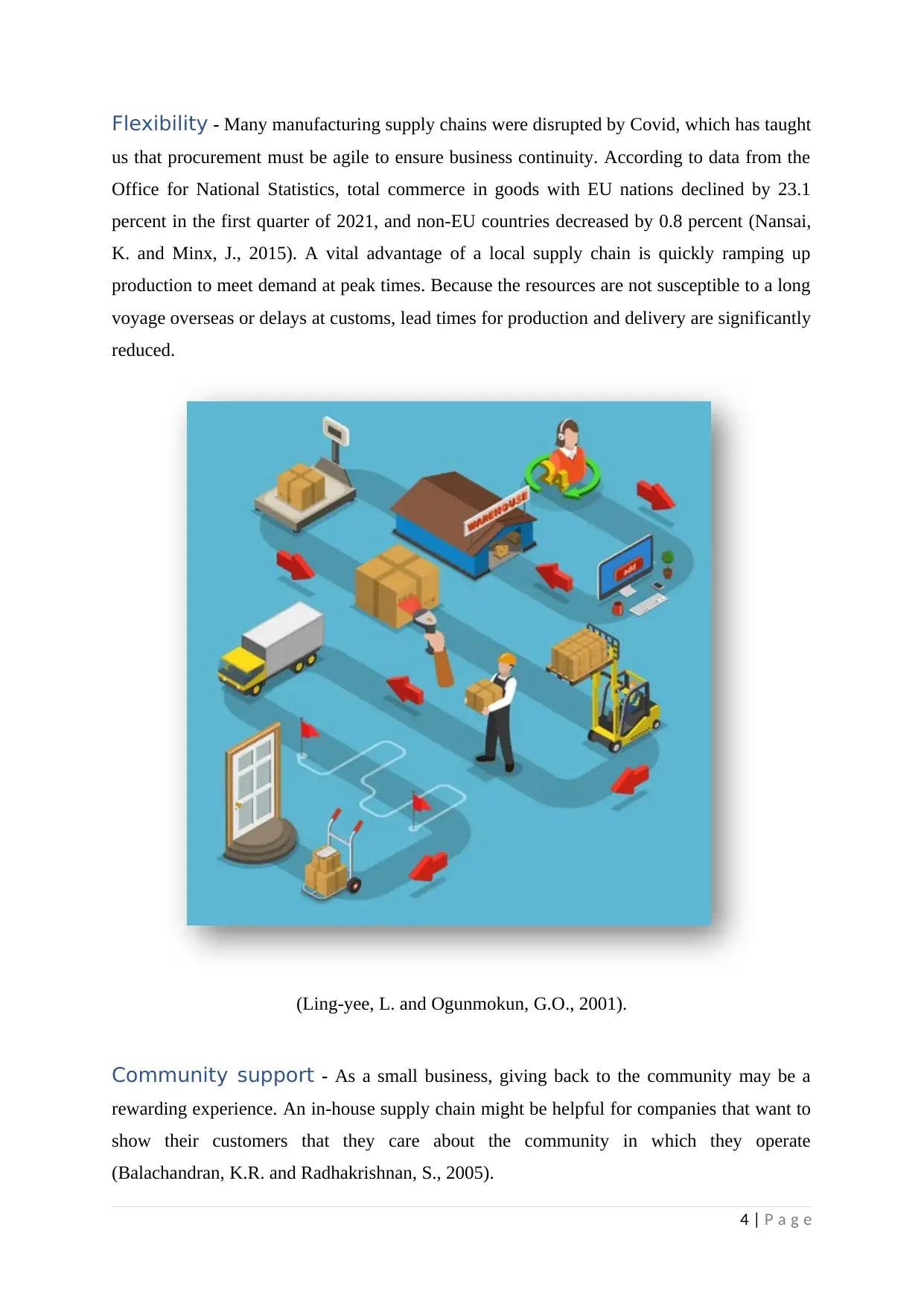
Flexibility - Many manufacturing supply chains were disrupted by Covid, which has taught
us that procurement must be agile to ensure business continuity. According to data from the
Office for National Statistics, total commerce in goods with EU nations declined by 23.1
percent in the first quarter of 2021, and non-EU countries decreased by 0.8 percent (Nansai,
K. and Minx, J., 2015). A vital advantage of a local supply chain is quickly ramping up
production to meet demand at peak times. Because the resources are not susceptible to a long
voyage overseas or delays at customs, lead times for production and delivery are significantly
reduced.
(Ling-yee, L. and Ogunmokun, G.O., 2001).
Community support - As a small business, giving back to the community may be a
rewarding experience. An in-house supply chain might be helpful for companies that want to
show their customers that they care about the community in which they operate
(Balachandran, K.R. and Radhakrishnan, S., 2005).
4 | P a g e
us that procurement must be agile to ensure business continuity. According to data from the
Office for National Statistics, total commerce in goods with EU nations declined by 23.1
percent in the first quarter of 2021, and non-EU countries decreased by 0.8 percent (Nansai,
K. and Minx, J., 2015). A vital advantage of a local supply chain is quickly ramping up
production to meet demand at peak times. Because the resources are not susceptible to a long
voyage overseas or delays at customs, lead times for production and delivery are significantly
reduced.
(Ling-yee, L. and Ogunmokun, G.O., 2001).
Community support - As a small business, giving back to the community may be a
rewarding experience. An in-house supply chain might be helpful for companies that want to
show their customers that they care about the community in which they operate
(Balachandran, K.R. and Radhakrishnan, S., 2005).
4 | P a g e
Paraphrase This Document
Need a fresh take? Get an instant paraphrase of this document with our AI Paraphraser
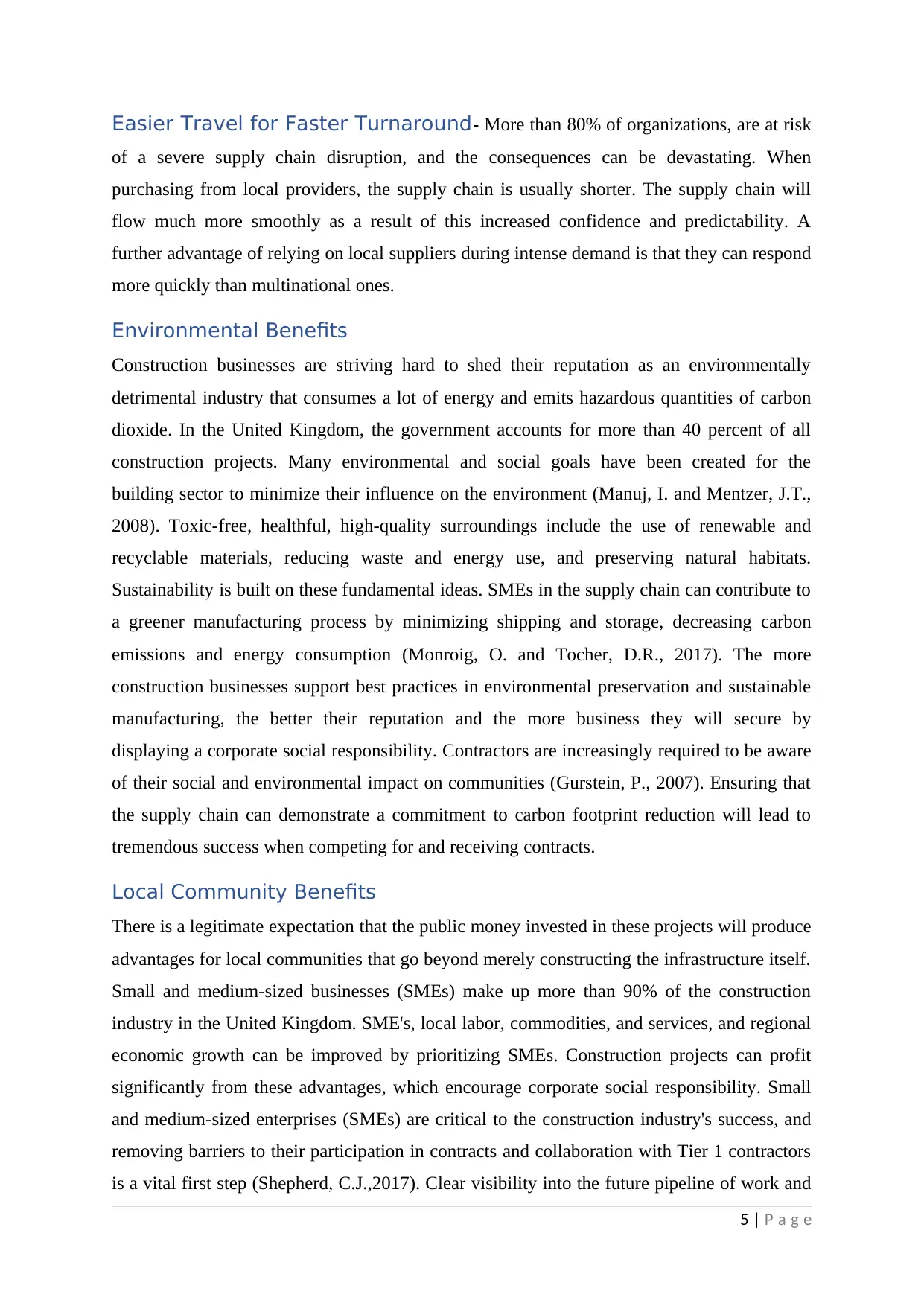
Easier Travel for Faster Turnaround- More than 80% of organizations, are at risk
of a severe supply chain disruption, and the consequences can be devastating. When
purchasing from local providers, the supply chain is usually shorter. The supply chain will
flow much more smoothly as a result of this increased confidence and predictability. A
further advantage of relying on local suppliers during intense demand is that they can respond
more quickly than multinational ones.
Environmental Benefits
Construction businesses are striving hard to shed their reputation as an environmentally
detrimental industry that consumes a lot of energy and emits hazardous quantities of carbon
dioxide. In the United Kingdom, the government accounts for more than 40 percent of all
construction projects. Many environmental and social goals have been created for the
building sector to minimize their influence on the environment (Manuj, I. and Mentzer, J.T.,
2008). Toxic-free, healthful, high-quality surroundings include the use of renewable and
recyclable materials, reducing waste and energy use, and preserving natural habitats.
Sustainability is built on these fundamental ideas. SMEs in the supply chain can contribute to
a greener manufacturing process by minimizing shipping and storage, decreasing carbon
emissions and energy consumption (Monroig, O. and Tocher, D.R., 2017). The more
construction businesses support best practices in environmental preservation and sustainable
manufacturing, the better their reputation and the more business they will secure by
displaying a corporate social responsibility. Contractors are increasingly required to be aware
of their social and environmental impact on communities (Gurstein, P., 2007). Ensuring that
the supply chain can demonstrate a commitment to carbon footprint reduction will lead to
tremendous success when competing for and receiving contracts.
Local Community Benefits
There is a legitimate expectation that the public money invested in these projects will produce
advantages for local communities that go beyond merely constructing the infrastructure itself.
Small and medium-sized businesses (SMEs) make up more than 90% of the construction
industry in the United Kingdom. SME's, local labor, commodities, and services, and regional
economic growth can be improved by prioritizing SMEs. Construction projects can profit
significantly from these advantages, which encourage corporate social responsibility. Small
and medium-sized enterprises (SMEs) are critical to the construction industry's success, and
removing barriers to their participation in contracts and collaboration with Tier 1 contractors
is a vital first step (Shepherd, C.J.,2017). Clear visibility into the future pipeline of work and
5 | P a g e
of a severe supply chain disruption, and the consequences can be devastating. When
purchasing from local providers, the supply chain is usually shorter. The supply chain will
flow much more smoothly as a result of this increased confidence and predictability. A
further advantage of relying on local suppliers during intense demand is that they can respond
more quickly than multinational ones.
Environmental Benefits
Construction businesses are striving hard to shed their reputation as an environmentally
detrimental industry that consumes a lot of energy and emits hazardous quantities of carbon
dioxide. In the United Kingdom, the government accounts for more than 40 percent of all
construction projects. Many environmental and social goals have been created for the
building sector to minimize their influence on the environment (Manuj, I. and Mentzer, J.T.,
2008). Toxic-free, healthful, high-quality surroundings include the use of renewable and
recyclable materials, reducing waste and energy use, and preserving natural habitats.
Sustainability is built on these fundamental ideas. SMEs in the supply chain can contribute to
a greener manufacturing process by minimizing shipping and storage, decreasing carbon
emissions and energy consumption (Monroig, O. and Tocher, D.R., 2017). The more
construction businesses support best practices in environmental preservation and sustainable
manufacturing, the better their reputation and the more business they will secure by
displaying a corporate social responsibility. Contractors are increasingly required to be aware
of their social and environmental impact on communities (Gurstein, P., 2007). Ensuring that
the supply chain can demonstrate a commitment to carbon footprint reduction will lead to
tremendous success when competing for and receiving contracts.
Local Community Benefits
There is a legitimate expectation that the public money invested in these projects will produce
advantages for local communities that go beyond merely constructing the infrastructure itself.
Small and medium-sized businesses (SMEs) make up more than 90% of the construction
industry in the United Kingdom. SME's, local labor, commodities, and services, and regional
economic growth can be improved by prioritizing SMEs. Construction projects can profit
significantly from these advantages, which encourage corporate social responsibility. Small
and medium-sized enterprises (SMEs) are critical to the construction industry's success, and
removing barriers to their participation in contracts and collaboration with Tier 1 contractors
is a vital first step (Shepherd, C.J.,2017). Clear visibility into the future pipeline of work and
5 | P a g e
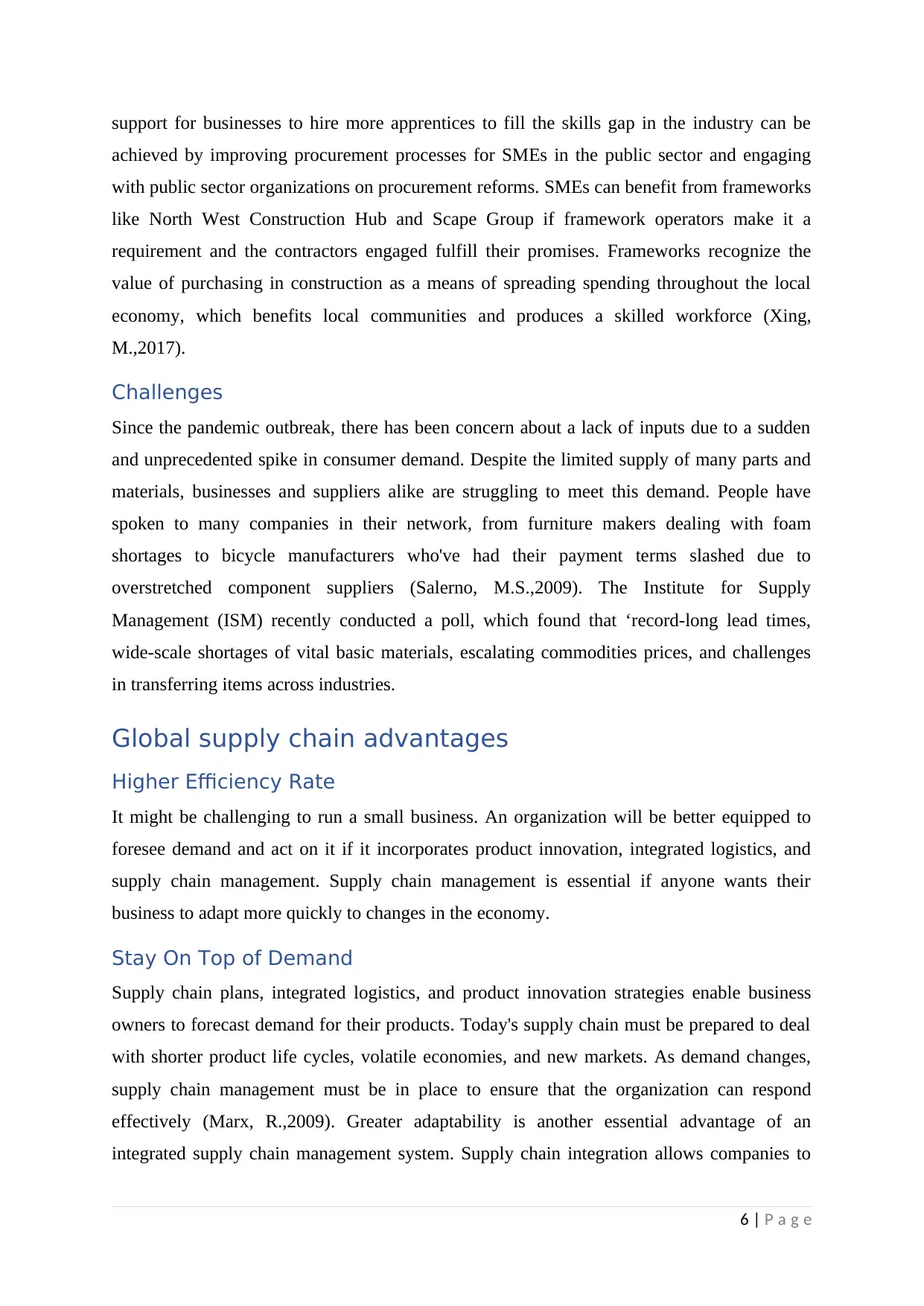
support for businesses to hire more apprentices to fill the skills gap in the industry can be
achieved by improving procurement processes for SMEs in the public sector and engaging
with public sector organizations on procurement reforms. SMEs can benefit from frameworks
like North West Construction Hub and Scape Group if framework operators make it a
requirement and the contractors engaged fulfill their promises. Frameworks recognize the
value of purchasing in construction as a means of spreading spending throughout the local
economy, which benefits local communities and produces a skilled workforce (Xing,
M.,2017).
Challenges
Since the pandemic outbreak, there has been concern about a lack of inputs due to a sudden
and unprecedented spike in consumer demand. Despite the limited supply of many parts and
materials, businesses and suppliers alike are struggling to meet this demand. People have
spoken to many companies in their network, from furniture makers dealing with foam
shortages to bicycle manufacturers who've had their payment terms slashed due to
overstretched component suppliers (Salerno, M.S.,2009). The Institute for Supply
Management (ISM) recently conducted a poll, which found that ‘record-long lead times,
wide-scale shortages of vital basic materials, escalating commodities prices, and challenges
in transferring items across industries.
Global supply chain advantages
Higher Efficiency Rate
It might be challenging to run a small business. An organization will be better equipped to
foresee demand and act on it if it incorporates product innovation, integrated logistics, and
supply chain management. Supply chain management is essential if anyone wants their
business to adapt more quickly to changes in the economy.
Stay On Top of Demand
Supply chain plans, integrated logistics, and product innovation strategies enable business
owners to forecast demand for their products. Today's supply chain must be prepared to deal
with shorter product life cycles, volatile economies, and new markets. As demand changes,
supply chain management must be in place to ensure that the organization can respond
effectively (Marx, R.,2009). Greater adaptability is another essential advantage of an
integrated supply chain management system. Supply chain integration allows companies to
6 | P a g e
achieved by improving procurement processes for SMEs in the public sector and engaging
with public sector organizations on procurement reforms. SMEs can benefit from frameworks
like North West Construction Hub and Scape Group if framework operators make it a
requirement and the contractors engaged fulfill their promises. Frameworks recognize the
value of purchasing in construction as a means of spreading spending throughout the local
economy, which benefits local communities and produces a skilled workforce (Xing,
M.,2017).
Challenges
Since the pandemic outbreak, there has been concern about a lack of inputs due to a sudden
and unprecedented spike in consumer demand. Despite the limited supply of many parts and
materials, businesses and suppliers alike are struggling to meet this demand. People have
spoken to many companies in their network, from furniture makers dealing with foam
shortages to bicycle manufacturers who've had their payment terms slashed due to
overstretched component suppliers (Salerno, M.S.,2009). The Institute for Supply
Management (ISM) recently conducted a poll, which found that ‘record-long lead times,
wide-scale shortages of vital basic materials, escalating commodities prices, and challenges
in transferring items across industries.
Global supply chain advantages
Higher Efficiency Rate
It might be challenging to run a small business. An organization will be better equipped to
foresee demand and act on it if it incorporates product innovation, integrated logistics, and
supply chain management. Supply chain management is essential if anyone wants their
business to adapt more quickly to changes in the economy.
Stay On Top of Demand
Supply chain plans, integrated logistics, and product innovation strategies enable business
owners to forecast demand for their products. Today's supply chain must be prepared to deal
with shorter product life cycles, volatile economies, and new markets. As demand changes,
supply chain management must be in place to ensure that the organization can respond
effectively (Marx, R.,2009). Greater adaptability is another essential advantage of an
integrated supply chain management system. Supply chain integration allows companies to
6 | P a g e
You're viewing a preview
Unlock full access by subscribing today!
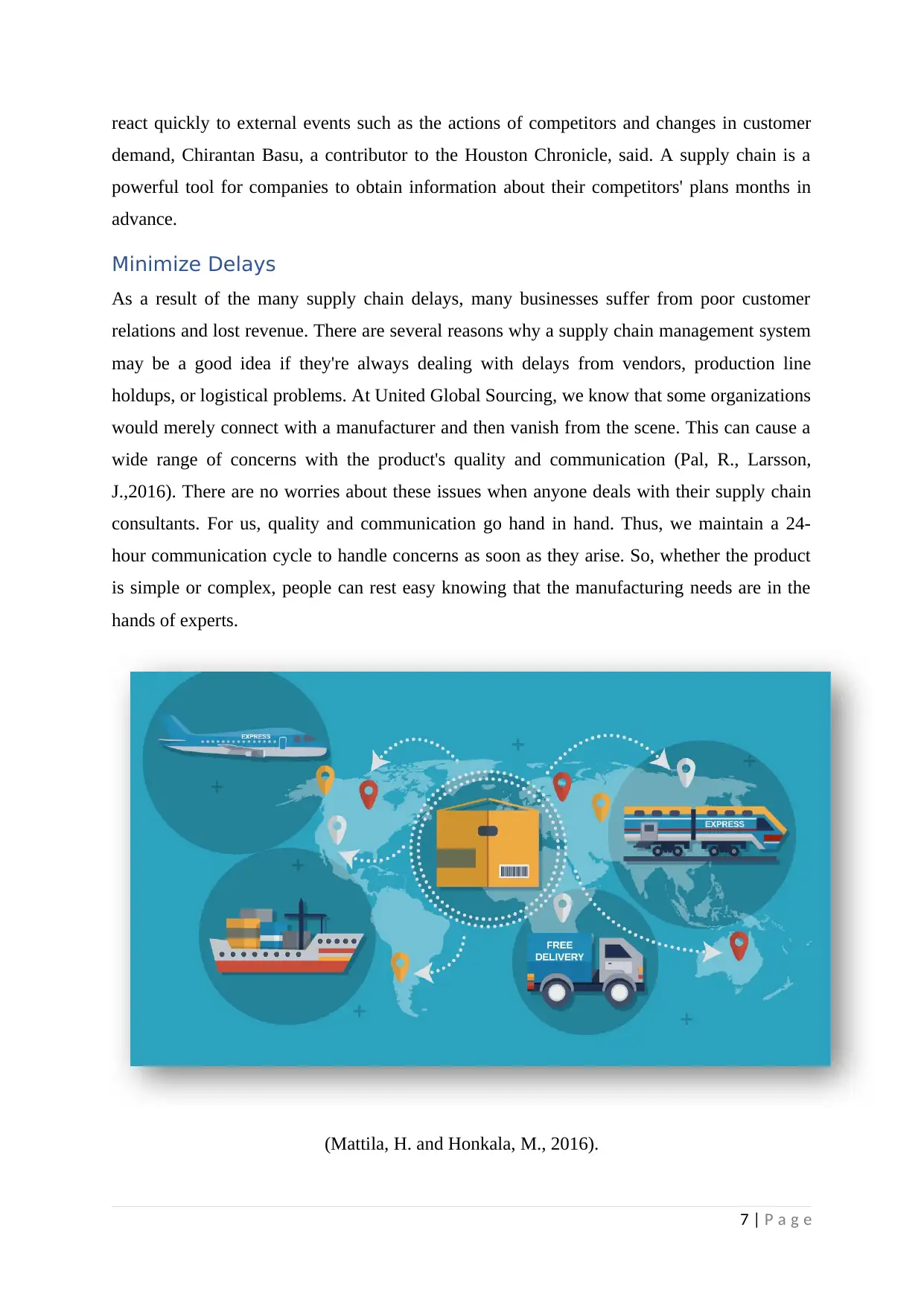
react quickly to external events such as the actions of competitors and changes in customer
demand, Chirantan Basu, a contributor to the Houston Chronicle, said. A supply chain is a
powerful tool for companies to obtain information about their competitors' plans months in
advance.
Minimize Delays
As a result of the many supply chain delays, many businesses suffer from poor customer
relations and lost revenue. There are several reasons why a supply chain management system
may be a good idea if they're always dealing with delays from vendors, production line
holdups, or logistical problems. At United Global Sourcing, we know that some organizations
would merely connect with a manufacturer and then vanish from the scene. This can cause a
wide range of concerns with the product's quality and communication (Pal, R., Larsson,
J.,2016). There are no worries about these issues when anyone deals with their supply chain
consultants. For us, quality and communication go hand in hand. Thus, we maintain a 24-
hour communication cycle to handle concerns as soon as they arise. So, whether the product
is simple or complex, people can rest easy knowing that the manufacturing needs are in the
hands of experts.
(Mattila, H. and Honkala, M., 2016).
7 | P a g e
demand, Chirantan Basu, a contributor to the Houston Chronicle, said. A supply chain is a
powerful tool for companies to obtain information about their competitors' plans months in
advance.
Minimize Delays
As a result of the many supply chain delays, many businesses suffer from poor customer
relations and lost revenue. There are several reasons why a supply chain management system
may be a good idea if they're always dealing with delays from vendors, production line
holdups, or logistical problems. At United Global Sourcing, we know that some organizations
would merely connect with a manufacturer and then vanish from the scene. This can cause a
wide range of concerns with the product's quality and communication (Pal, R., Larsson,
J.,2016). There are no worries about these issues when anyone deals with their supply chain
consultants. For us, quality and communication go hand in hand. Thus, we maintain a 24-
hour communication cycle to handle concerns as soon as they arise. So, whether the product
is simple or complex, people can rest easy knowing that the manufacturing needs are in the
hands of experts.
(Mattila, H. and Honkala, M., 2016).
7 | P a g e
Paraphrase This Document
Need a fresh take? Get an instant paraphrase of this document with our AI Paraphraser
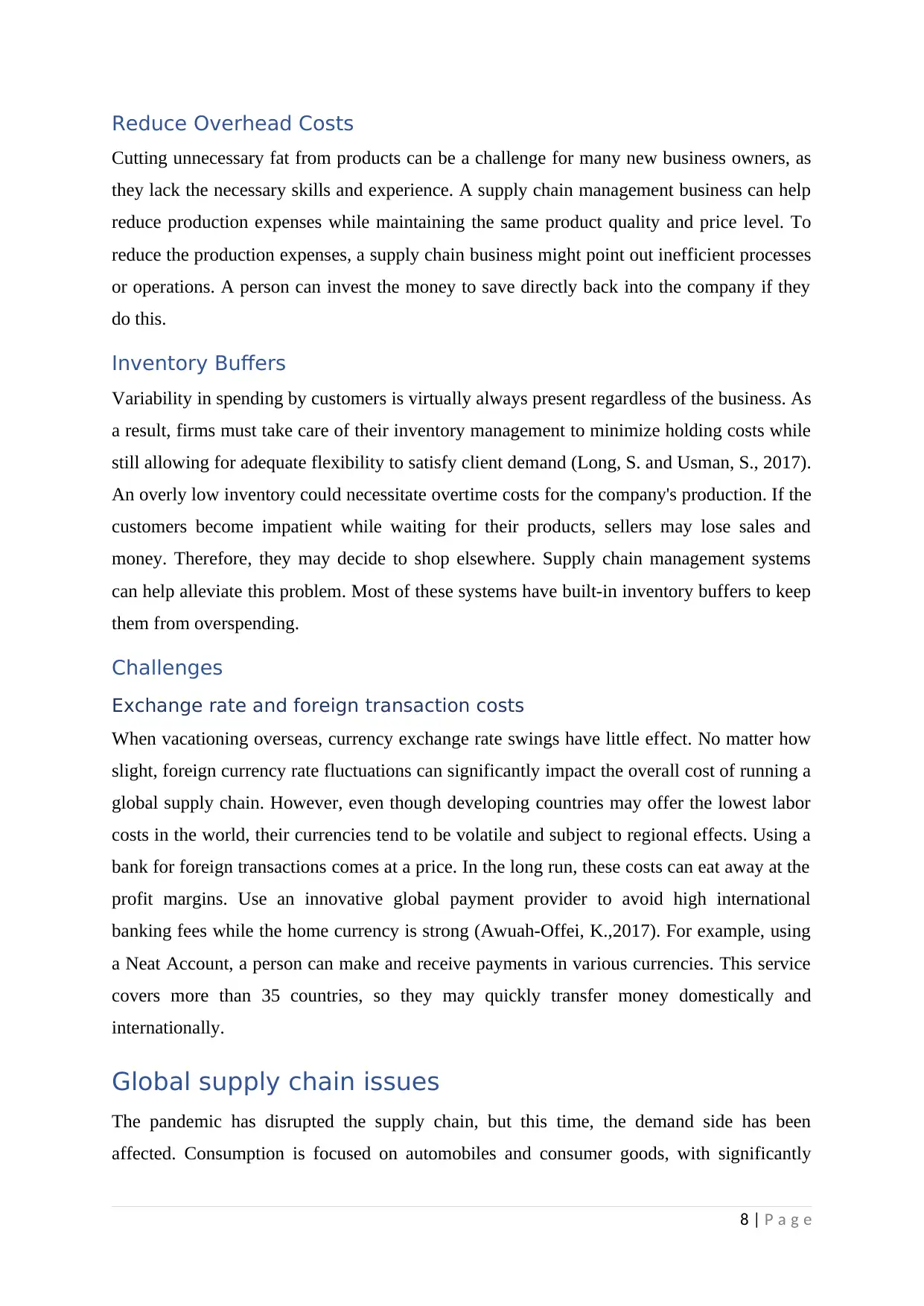
Reduce Overhead Costs
Cutting unnecessary fat from products can be a challenge for many new business owners, as
they lack the necessary skills and experience. A supply chain management business can help
reduce production expenses while maintaining the same product quality and price level. To
reduce the production expenses, a supply chain business might point out inefficient processes
or operations. A person can invest the money to save directly back into the company if they
do this.
Inventory Buffers
Variability in spending by customers is virtually always present regardless of the business. As
a result, firms must take care of their inventory management to minimize holding costs while
still allowing for adequate flexibility to satisfy client demand (Long, S. and Usman, S., 2017).
An overly low inventory could necessitate overtime costs for the company's production. If the
customers become impatient while waiting for their products, sellers may lose sales and
money. Therefore, they may decide to shop elsewhere. Supply chain management systems
can help alleviate this problem. Most of these systems have built-in inventory buffers to keep
them from overspending.
Challenges
Exchange rate and foreign transaction costs
When vacationing overseas, currency exchange rate swings have little effect. No matter how
slight, foreign currency rate fluctuations can significantly impact the overall cost of running a
global supply chain. However, even though developing countries may offer the lowest labor
costs in the world, their currencies tend to be volatile and subject to regional effects. Using a
bank for foreign transactions comes at a price. In the long run, these costs can eat away at the
profit margins. Use an innovative global payment provider to avoid high international
banking fees while the home currency is strong (Awuah-Offei, K.,2017). For example, using
a Neat Account, a person can make and receive payments in various currencies. This service
covers more than 35 countries, so they may quickly transfer money domestically and
internationally.
Global supply chain issues
The pandemic has disrupted the supply chain, but this time, the demand side has been
affected. Consumption is focused on automobiles and consumer goods, with significantly
8 | P a g e
Cutting unnecessary fat from products can be a challenge for many new business owners, as
they lack the necessary skills and experience. A supply chain management business can help
reduce production expenses while maintaining the same product quality and price level. To
reduce the production expenses, a supply chain business might point out inefficient processes
or operations. A person can invest the money to save directly back into the company if they
do this.
Inventory Buffers
Variability in spending by customers is virtually always present regardless of the business. As
a result, firms must take care of their inventory management to minimize holding costs while
still allowing for adequate flexibility to satisfy client demand (Long, S. and Usman, S., 2017).
An overly low inventory could necessitate overtime costs for the company's production. If the
customers become impatient while waiting for their products, sellers may lose sales and
money. Therefore, they may decide to shop elsewhere. Supply chain management systems
can help alleviate this problem. Most of these systems have built-in inventory buffers to keep
them from overspending.
Challenges
Exchange rate and foreign transaction costs
When vacationing overseas, currency exchange rate swings have little effect. No matter how
slight, foreign currency rate fluctuations can significantly impact the overall cost of running a
global supply chain. However, even though developing countries may offer the lowest labor
costs in the world, their currencies tend to be volatile and subject to regional effects. Using a
bank for foreign transactions comes at a price. In the long run, these costs can eat away at the
profit margins. Use an innovative global payment provider to avoid high international
banking fees while the home currency is strong (Awuah-Offei, K.,2017). For example, using
a Neat Account, a person can make and receive payments in various currencies. This service
covers more than 35 countries, so they may quickly transfer money domestically and
internationally.
Global supply chain issues
The pandemic has disrupted the supply chain, but this time, the demand side has been
affected. Consumption is focused on automobiles and consumer goods, with significantly
8 | P a g e
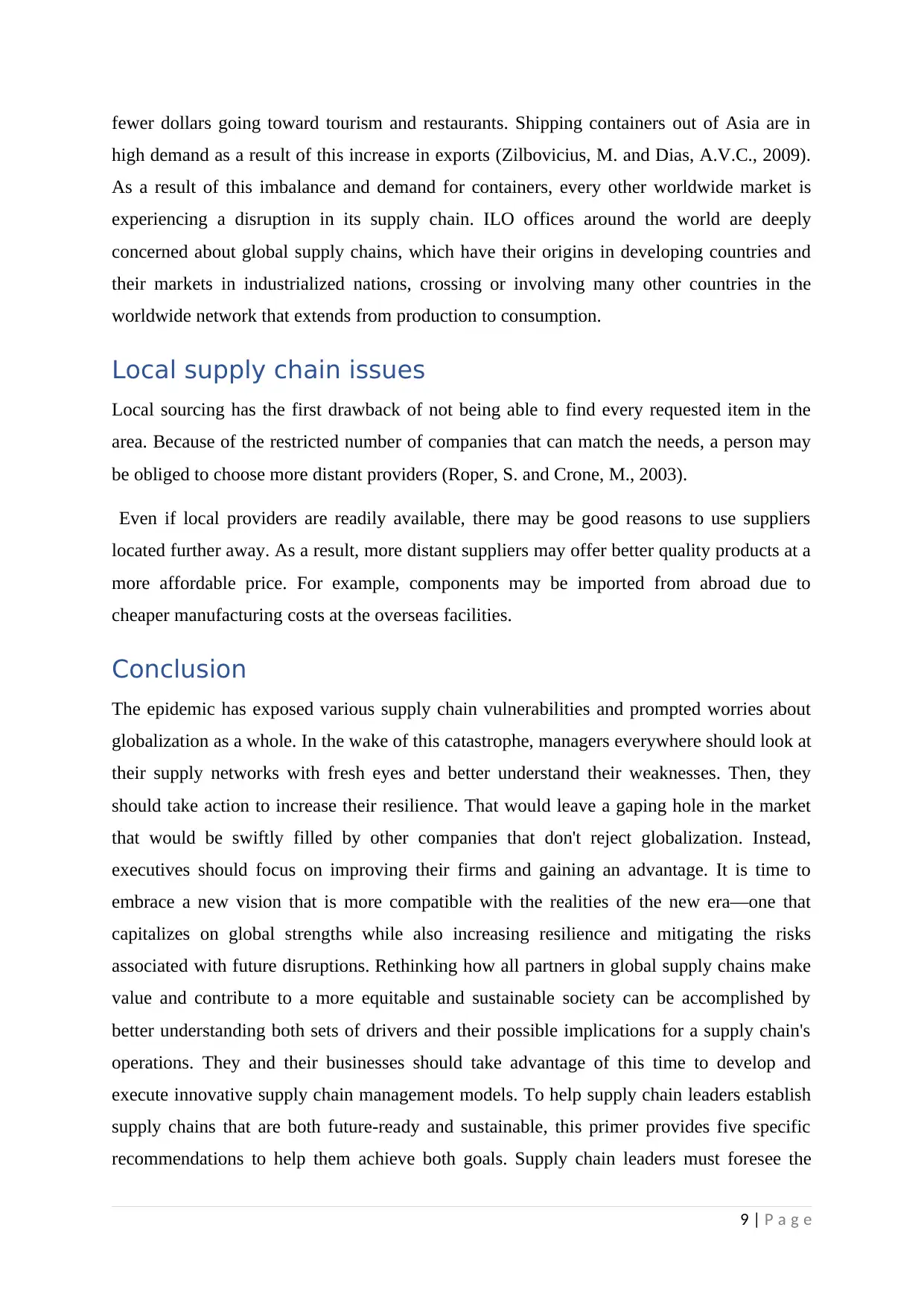
fewer dollars going toward tourism and restaurants. Shipping containers out of Asia are in
high demand as a result of this increase in exports (Zilbovicius, M. and Dias, A.V.C., 2009).
As a result of this imbalance and demand for containers, every other worldwide market is
experiencing a disruption in its supply chain. ILO offices around the world are deeply
concerned about global supply chains, which have their origins in developing countries and
their markets in industrialized nations, crossing or involving many other countries in the
worldwide network that extends from production to consumption.
Local supply chain issues
Local sourcing has the first drawback of not being able to find every requested item in the
area. Because of the restricted number of companies that can match the needs, a person may
be obliged to choose more distant providers (Roper, S. and Crone, M., 2003).
Even if local providers are readily available, there may be good reasons to use suppliers
located further away. As a result, more distant suppliers may offer better quality products at a
more affordable price. For example, components may be imported from abroad due to
cheaper manufacturing costs at the overseas facilities.
Conclusion
The epidemic has exposed various supply chain vulnerabilities and prompted worries about
globalization as a whole. In the wake of this catastrophe, managers everywhere should look at
their supply networks with fresh eyes and better understand their weaknesses. Then, they
should take action to increase their resilience. That would leave a gaping hole in the market
that would be swiftly filled by other companies that don't reject globalization. Instead,
executives should focus on improving their firms and gaining an advantage. It is time to
embrace a new vision that is more compatible with the realities of the new era—one that
capitalizes on global strengths while also increasing resilience and mitigating the risks
associated with future disruptions. Rethinking how all partners in global supply chains make
value and contribute to a more equitable and sustainable society can be accomplished by
better understanding both sets of drivers and their possible implications for a supply chain's
operations. They and their businesses should take advantage of this time to develop and
execute innovative supply chain management models. To help supply chain leaders establish
supply chains that are both future-ready and sustainable, this primer provides five specific
recommendations to help them achieve both goals. Supply chain leaders must foresee the
9 | P a g e
high demand as a result of this increase in exports (Zilbovicius, M. and Dias, A.V.C., 2009).
As a result of this imbalance and demand for containers, every other worldwide market is
experiencing a disruption in its supply chain. ILO offices around the world are deeply
concerned about global supply chains, which have their origins in developing countries and
their markets in industrialized nations, crossing or involving many other countries in the
worldwide network that extends from production to consumption.
Local supply chain issues
Local sourcing has the first drawback of not being able to find every requested item in the
area. Because of the restricted number of companies that can match the needs, a person may
be obliged to choose more distant providers (Roper, S. and Crone, M., 2003).
Even if local providers are readily available, there may be good reasons to use suppliers
located further away. As a result, more distant suppliers may offer better quality products at a
more affordable price. For example, components may be imported from abroad due to
cheaper manufacturing costs at the overseas facilities.
Conclusion
The epidemic has exposed various supply chain vulnerabilities and prompted worries about
globalization as a whole. In the wake of this catastrophe, managers everywhere should look at
their supply networks with fresh eyes and better understand their weaknesses. Then, they
should take action to increase their resilience. That would leave a gaping hole in the market
that would be swiftly filled by other companies that don't reject globalization. Instead,
executives should focus on improving their firms and gaining an advantage. It is time to
embrace a new vision that is more compatible with the realities of the new era—one that
capitalizes on global strengths while also increasing resilience and mitigating the risks
associated with future disruptions. Rethinking how all partners in global supply chains make
value and contribute to a more equitable and sustainable society can be accomplished by
better understanding both sets of drivers and their possible implications for a supply chain's
operations. They and their businesses should take advantage of this time to develop and
execute innovative supply chain management models. To help supply chain leaders establish
supply chains that are both future-ready and sustainable, this primer provides five specific
recommendations to help them achieve both goals. Supply chain leaders must foresee the
9 | P a g e
You're viewing a preview
Unlock full access by subscribing today!
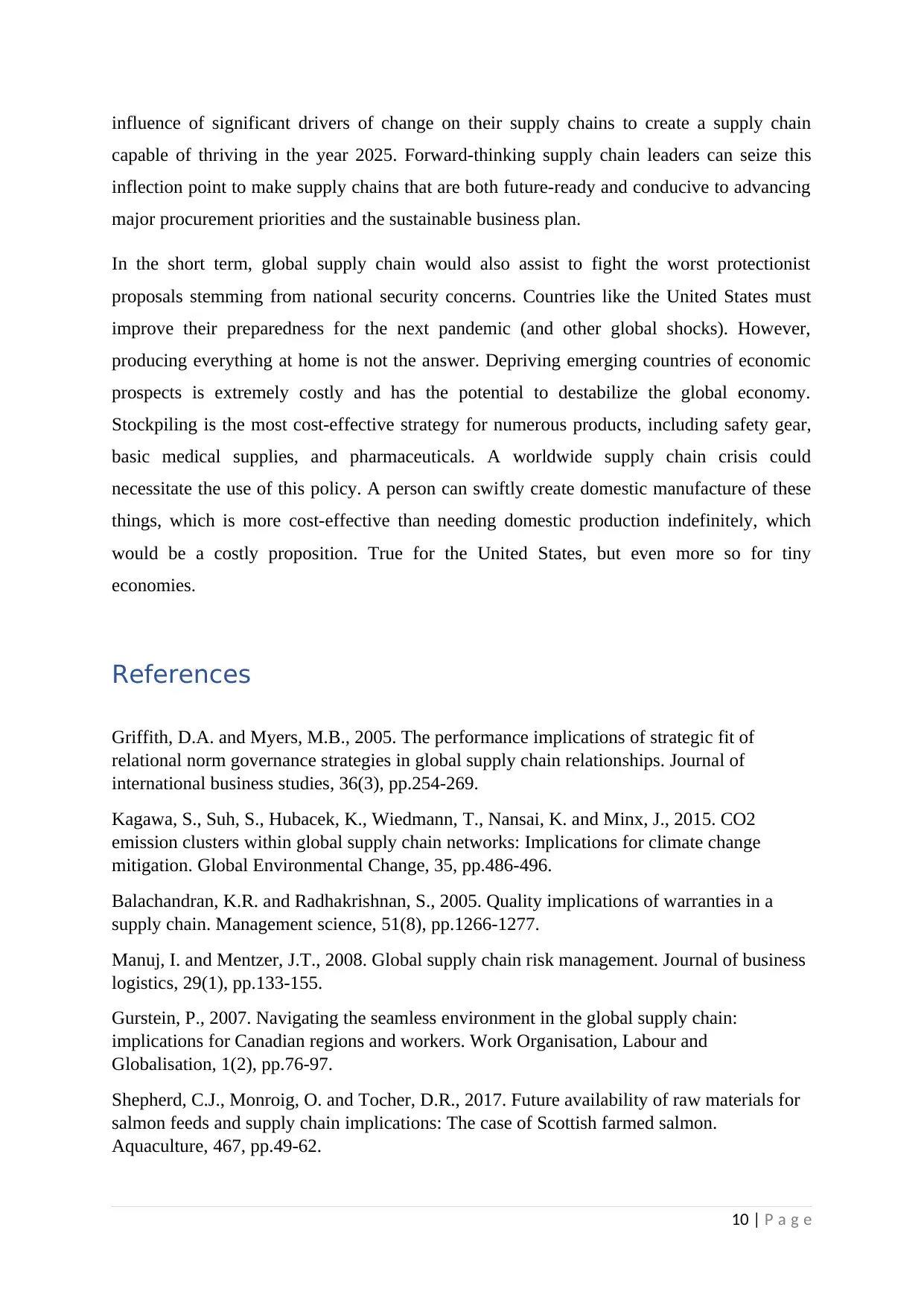
influence of significant drivers of change on their supply chains to create a supply chain
capable of thriving in the year 2025. Forward-thinking supply chain leaders can seize this
inflection point to make supply chains that are both future-ready and conducive to advancing
major procurement priorities and the sustainable business plan.
In the short term, global supply chain would also assist to fight the worst protectionist
proposals stemming from national security concerns. Countries like the United States must
improve their preparedness for the next pandemic (and other global shocks). However,
producing everything at home is not the answer. Depriving emerging countries of economic
prospects is extremely costly and has the potential to destabilize the global economy.
Stockpiling is the most cost-effective strategy for numerous products, including safety gear,
basic medical supplies, and pharmaceuticals. A worldwide supply chain crisis could
necessitate the use of this policy. A person can swiftly create domestic manufacture of these
things, which is more cost-effective than needing domestic production indefinitely, which
would be a costly proposition. True for the United States, but even more so for tiny
economies.
References
Griffith, D.A. and Myers, M.B., 2005. The performance implications of strategic fit of
relational norm governance strategies in global supply chain relationships. Journal of
international business studies, 36(3), pp.254-269.
Kagawa, S., Suh, S., Hubacek, K., Wiedmann, T., Nansai, K. and Minx, J., 2015. CO2
emission clusters within global supply chain networks: Implications for climate change
mitigation. Global Environmental Change, 35, pp.486-496.
Balachandran, K.R. and Radhakrishnan, S., 2005. Quality implications of warranties in a
supply chain. Management science, 51(8), pp.1266-1277.
Manuj, I. and Mentzer, J.T., 2008. Global supply chain risk management. Journal of business
logistics, 29(1), pp.133-155.
Gurstein, P., 2007. Navigating the seamless environment in the global supply chain:
implications for Canadian regions and workers. Work Organisation, Labour and
Globalisation, 1(2), pp.76-97.
Shepherd, C.J., Monroig, O. and Tocher, D.R., 2017. Future availability of raw materials for
salmon feeds and supply chain implications: The case of Scottish farmed salmon.
Aquaculture, 467, pp.49-62.
10 | P a g e
capable of thriving in the year 2025. Forward-thinking supply chain leaders can seize this
inflection point to make supply chains that are both future-ready and conducive to advancing
major procurement priorities and the sustainable business plan.
In the short term, global supply chain would also assist to fight the worst protectionist
proposals stemming from national security concerns. Countries like the United States must
improve their preparedness for the next pandemic (and other global shocks). However,
producing everything at home is not the answer. Depriving emerging countries of economic
prospects is extremely costly and has the potential to destabilize the global economy.
Stockpiling is the most cost-effective strategy for numerous products, including safety gear,
basic medical supplies, and pharmaceuticals. A worldwide supply chain crisis could
necessitate the use of this policy. A person can swiftly create domestic manufacture of these
things, which is more cost-effective than needing domestic production indefinitely, which
would be a costly proposition. True for the United States, but even more so for tiny
economies.
References
Griffith, D.A. and Myers, M.B., 2005. The performance implications of strategic fit of
relational norm governance strategies in global supply chain relationships. Journal of
international business studies, 36(3), pp.254-269.
Kagawa, S., Suh, S., Hubacek, K., Wiedmann, T., Nansai, K. and Minx, J., 2015. CO2
emission clusters within global supply chain networks: Implications for climate change
mitigation. Global Environmental Change, 35, pp.486-496.
Balachandran, K.R. and Radhakrishnan, S., 2005. Quality implications of warranties in a
supply chain. Management science, 51(8), pp.1266-1277.
Manuj, I. and Mentzer, J.T., 2008. Global supply chain risk management. Journal of business
logistics, 29(1), pp.133-155.
Gurstein, P., 2007. Navigating the seamless environment in the global supply chain:
implications for Canadian regions and workers. Work Organisation, Labour and
Globalisation, 1(2), pp.76-97.
Shepherd, C.J., Monroig, O. and Tocher, D.R., 2017. Future availability of raw materials for
salmon feeds and supply chain implications: The case of Scottish farmed salmon.
Aquaculture, 467, pp.49-62.
10 | P a g e
Paraphrase This Document
Need a fresh take? Get an instant paraphrase of this document with our AI Paraphraser
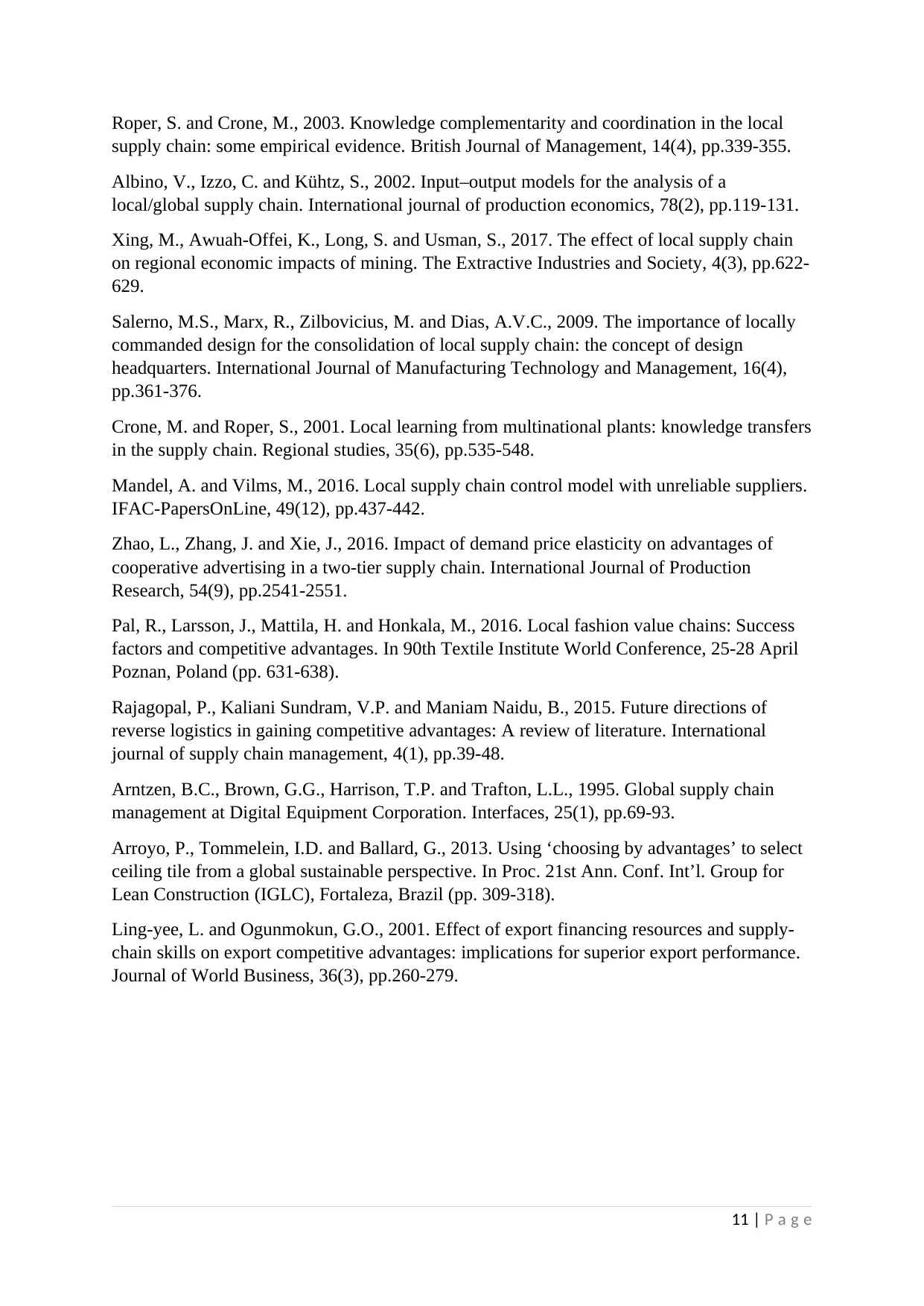
Roper, S. and Crone, M., 2003. Knowledge complementarity and coordination in the local
supply chain: some empirical evidence. British Journal of Management, 14(4), pp.339-355.
Albino, V., Izzo, C. and Kühtz, S., 2002. Input–output models for the analysis of a
local/global supply chain. International journal of production economics, 78(2), pp.119-131.
Xing, M., Awuah-Offei, K., Long, S. and Usman, S., 2017. The effect of local supply chain
on regional economic impacts of mining. The Extractive Industries and Society, 4(3), pp.622-
629.
Salerno, M.S., Marx, R., Zilbovicius, M. and Dias, A.V.C., 2009. The importance of locally
commanded design for the consolidation of local supply chain: the concept of design
headquarters. International Journal of Manufacturing Technology and Management, 16(4),
pp.361-376.
Crone, M. and Roper, S., 2001. Local learning from multinational plants: knowledge transfers
in the supply chain. Regional studies, 35(6), pp.535-548.
Mandel, A. and Vilms, M., 2016. Local supply chain control model with unreliable suppliers.
IFAC-PapersOnLine, 49(12), pp.437-442.
Zhao, L., Zhang, J. and Xie, J., 2016. Impact of demand price elasticity on advantages of
cooperative advertising in a two-tier supply chain. International Journal of Production
Research, 54(9), pp.2541-2551.
Pal, R., Larsson, J., Mattila, H. and Honkala, M., 2016. Local fashion value chains: Success
factors and competitive advantages. In 90th Textile Institute World Conference, 25-28 April
Poznan, Poland (pp. 631-638).
Rajagopal, P., Kaliani Sundram, V.P. and Maniam Naidu, B., 2015. Future directions of
reverse logistics in gaining competitive advantages: A review of literature. International
journal of supply chain management, 4(1), pp.39-48.
Arntzen, B.C., Brown, G.G., Harrison, T.P. and Trafton, L.L., 1995. Global supply chain
management at Digital Equipment Corporation. Interfaces, 25(1), pp.69-93.
Arroyo, P., Tommelein, I.D. and Ballard, G., 2013. Using ‘choosing by advantages’ to select
ceiling tile from a global sustainable perspective. In Proc. 21st Ann. Conf. Int’l. Group for
Lean Construction (IGLC), Fortaleza, Brazil (pp. 309-318).
Ling-yee, L. and Ogunmokun, G.O., 2001. Effect of export financing resources and supply-
chain skills on export competitive advantages: implications for superior export performance.
Journal of World Business, 36(3), pp.260-279.
11 | P a g e
supply chain: some empirical evidence. British Journal of Management, 14(4), pp.339-355.
Albino, V., Izzo, C. and Kühtz, S., 2002. Input–output models for the analysis of a
local/global supply chain. International journal of production economics, 78(2), pp.119-131.
Xing, M., Awuah-Offei, K., Long, S. and Usman, S., 2017. The effect of local supply chain
on regional economic impacts of mining. The Extractive Industries and Society, 4(3), pp.622-
629.
Salerno, M.S., Marx, R., Zilbovicius, M. and Dias, A.V.C., 2009. The importance of locally
commanded design for the consolidation of local supply chain: the concept of design
headquarters. International Journal of Manufacturing Technology and Management, 16(4),
pp.361-376.
Crone, M. and Roper, S., 2001. Local learning from multinational plants: knowledge transfers
in the supply chain. Regional studies, 35(6), pp.535-548.
Mandel, A. and Vilms, M., 2016. Local supply chain control model with unreliable suppliers.
IFAC-PapersOnLine, 49(12), pp.437-442.
Zhao, L., Zhang, J. and Xie, J., 2016. Impact of demand price elasticity on advantages of
cooperative advertising in a two-tier supply chain. International Journal of Production
Research, 54(9), pp.2541-2551.
Pal, R., Larsson, J., Mattila, H. and Honkala, M., 2016. Local fashion value chains: Success
factors and competitive advantages. In 90th Textile Institute World Conference, 25-28 April
Poznan, Poland (pp. 631-638).
Rajagopal, P., Kaliani Sundram, V.P. and Maniam Naidu, B., 2015. Future directions of
reverse logistics in gaining competitive advantages: A review of literature. International
journal of supply chain management, 4(1), pp.39-48.
Arntzen, B.C., Brown, G.G., Harrison, T.P. and Trafton, L.L., 1995. Global supply chain
management at Digital Equipment Corporation. Interfaces, 25(1), pp.69-93.
Arroyo, P., Tommelein, I.D. and Ballard, G., 2013. Using ‘choosing by advantages’ to select
ceiling tile from a global sustainable perspective. In Proc. 21st Ann. Conf. Int’l. Group for
Lean Construction (IGLC), Fortaleza, Brazil (pp. 309-318).
Ling-yee, L. and Ogunmokun, G.O., 2001. Effect of export financing resources and supply-
chain skills on export competitive advantages: implications for superior export performance.
Journal of World Business, 36(3), pp.260-279.
11 | P a g e
1 out of 11
Related Documents
Your All-in-One AI-Powered Toolkit for Academic Success.
+13062052269
info@desklib.com
Available 24*7 on WhatsApp / Email
![[object Object]](/_next/static/media/star-bottom.7253800d.svg)
Unlock your academic potential
© 2024 | Zucol Services PVT LTD | All rights reserved.




